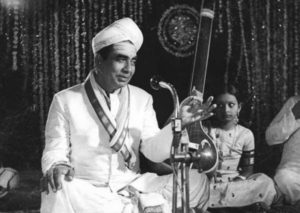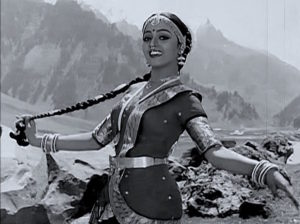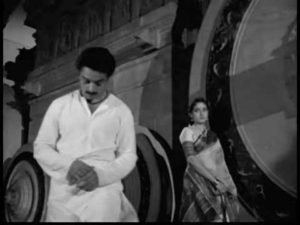Preface
"I offer a hundred thousand salutations to the donor who extended his hands to guard the flame of pure traditional classical music, fluttering under the assault of the tornado of Western music," says a visibly moved Shankara Sastri, moments before he can begin the final classical music concert of his life.
While that scene marks the end of Kasinathuni Viswanath’s landmark classic, Sankarabharanam, it equally heralds an unparalleled artistic departure, a fresh beginning in his cinematic career lasting more than five decades. The Telugu director who until Sankarabharanam had only made social movies debuting with the 1965 superhit Atma Gowravam, had reemerged with a musical and cultural triumph on celluloid.
Very few movies have made such widespread cultural and social impact as Sankarabharanam when we consider the fact that almost every scene, song, and dialogue became staple household diet in South Indian homes given the fact that it was a Telugu film. The lyrics of the movie’s opening song, Omkara naadanu sandhanam… was retained as is when it was dubbed in Malayalam with zero loss in translation and audience appreciation.
On the other side, this film not only reopened, almost overnight, the eyes of Indians to the greatness of their own classical music, but there was an immediate rush for its teachers. In turn, students asked their Gurus to teach traditional compositions used in the film: Brochevarevarura (composed by Mysore Vasudevacharya), Samaja Varagamana (Saint Thyagaraja), and Manasa Sancharare (Sadasiva Brahmendra).
When the film's crew toured (undivided) Andhra Pradesh after it completed 100 days, J V Somayajulu (who played the protagonist Shankara Sastri) had to pay special attention to his attire and demeanour in public—the same public that had elevated him to the status of a saint. It is said, back in the day, he found it tough to wear shirts and trousers or, more dangerously, stepping aside for a smoke-break.
This impact is vastly different from the kind of impact that Sholay had and is rarely, if ever, mentioned in the annals of film criticism. We can leave it at that. No other movie of K Viswanath post Sankarabharanam was able to attain the same iconic level of a cultural landmark so to speak.
An Appreciation
The reason for dwelling at length on Sankarabharanam—apart from the aforementioned distinction and the decisive turn it marked in Viswanath’s cinematic career—is to present the backdrop and the theme of this essay whose main thrust is an appreciation of the craft and art of his filmmaking beginning with Sankarabharanam.
The dominant “school” of literary and art criticism, a continuing holdover of Leftist interpretative perversions holds that it’s akin to a sort of sin to analyze a work of art from the vantage of a Sahrudaya, a genuine connoisseur who seeks to appreciate art as a unified experience than prick holes using extraneous theories.
One of the chief difficulties with this sort of approach lies in the nature and complexity of the medium of cinema itself, which lends itself to a far greater expanse, scale, and sweep than a play. With regard to Viswanath’s films where art is both spread over and blended in numerous layers of plot, music, dance, dialogue, lyric, and even individual scenes, it is a challenge to analyze it using a specific prism. Which is why this essay endeavours to place the analysis in a framework comprising three aspects: the country (in the sense of Rashtra), the society and the individual. The fourth aspect will separately focus on the artistic approach of K. Viswanath.
The Country
A characteristic trait of almost all artists rooted in the Indian classical milieu is the striking and native manner in which they display their abiding love for the sanctified geography of Bharatavarsha.
In this, whether or not they’re consciously aware of it, they follow the hoary tradition laid down and immortalized by Kalidasa, most notably in his Meghadootam in which the poet’s choice of the cloud as a messenger who traverses across India is as aptly extraordinary as the vivid pictures he paints of our country’s vast, varied, and lush landscape.
Equally, Kalidasa’s other immortal classic Kumarasambhavam opens with a majestic description of the Himalayas, a feat he continues in the Third, Fifth and Sixth cantos and in the Eighth, describes the beauty of various regions of Bharata as the newly-wedded Parvati and Shiva embark on an all-India honeymoon. Kalidasa’s insatiable appetite for and attachment towards the physical geography of Bharata is also reflected in his grand Mahakavya (long narrative poetry), Raghuvamsham: in the Fourth canto narrating King Raghu’s victorious conquest (Digvijaya), in the Sixth canto narrating Indumati’s Swayamvara (wedding where the bride chooses her groom all by herself), and in the Thirteenth canto narrating the return of Sita and Rama in the Pushpaka Vimana.
The towering scholar Dr. S Srikanta Sastri poignantly, succinctly describes[i] the nature of this sanctified geography thus:
The culture of India, like the country itself, is indivisible and timeless. Just like its indivisible geography that stretches from Kashmir to Kanyakumari, from Vishweshwara to Rameshwara, from Bindu Madhava to Sethu Madhava, Indian culture too represents this indivisible continuum from the Rishis of the Vedas all the way up to Ramakrishna Paramahamsa… The ancients were unanimous in the view that this region was sacred and that its dharma, language, and culture was a unified whole . They held that one had to accumulate virtues in past births to be born in such a land.
Thus, the term “Bharata” resonating with poignant meaning, is indicative of Mother India’s Vedas, sage Bharata’s treatise on performing arts, rishi Jada-Bharata’s spiritual tenets, king Bharata-Sarvadamana’s empire, the abundance of wealth and natural resources, and the tremendous nourishing strength of Mother India.
It is to constantly remind the people of Bharata of this conception of Bharata as a unified whole that Indian culture provides a spiritual dimension to the physical and geographical features of India.
This unified wholeness is also discernible when one performs the Sankalpa. During Sankalpa, one invokes the current time in the endless cycle of time and the names of various sacred places in India.
Similarly, this unified wholeness can be experienced by visiting the various pilgrimage spots that Indians regard as sacred. This wholeness is further evident when we examine Tantrashastra where the body is regarded as the country and Tantric yogic practices are performed according to the rules laid down in Tantrashastra.
Equally, in the Yoga of Mantra, we worship the Parashakti by recalling all the Yogini Peethas (or Shakti Peethas) located in different parts of India… This resonates well with Adi Shankara’s saying that there’s no difference between one’s mother and one’s motherland. Every place of pilgrimage and Yogini Peetha in India reflects the awareness of this spiritual energy. It is no exaggeration to say that the whole of Bharata is the body, which enables the realization of both material and spiritual goals.
In our own time, several works of the pan Indian literary colossus Dr. S L Bhyrappa reflect the same conception of India’s spiritual geography. His musings on the role that the Himalayas, Kailasa Manasa Sarovara, Varanasi, and Ganga have played in shaping his literature are deep, illuminative, and insightful.
Although K. Viswanath isn’t in the same league, his movies aesthetically reflect this same conception of Bharata’s sacred geography. This is predominantly portrayed in numerous song sequences shot in cultural and pilgrimage sites spread across the vast expanse of Bharata.
His 1988 blockbuster Swarnakamalam featured song and dance sequences shot at Puri, the Himalayas, the verdant Valley of Flowers resting in the lap of the Himalayan ranges in Uttarakhand, the Dhauli Stupa (Odisha), and Vishakhapatanam. Similarly, the lilting romantic melody Mounamelanoyi features the magnificent, sacred architecture of Valluvar Kottam near Chennai as does the full range of beauty of Melukote in numerous sequences in his other classic, Swati Muthyam. Viswanath’s Sirivennela also showcases the grandeur of Jaipur not merely as a popular tourist destination of large and elegant palaces and forts but as a bygone center of Hindustani classical music. It’s fitting that portions of the music for Sirivennela were composed by Pandit Hari Prasad Chaurasia who supplied the melody for the film’s protagonist who’s a blind flutist.
His 1987 musical, Shruti Layalu takes us to the backwaters as well as to the expanse of the sea at Vishakhapatnam, providing a soothing backdrop for a classical music school. This apart, a significant chunk of the movie was filmed in Haridwar where he showcases not just the eons-long sanctity of the city but uses it as a setting for the talented child Shanmukha Srinivas’s debut as a classical dancer, swaying to Sri Narayana Teertha’s Aalokaye Sri Balakrishnam even as the venerated Ganga courses uninterrupted in the background.
Two factors elevate this nuanced and creative use of Bharata’s geography in cinema into fine art in the hands of Viswanath.
The first is the fact that one needs to remember the period in which he shot these movies. It was the era in Telugu cinema which witnessed a slew of expensive and mind-numbing “dream songs” shot abroad—mostly Switzerland—even when there was no requirement for such songs. One fails to understand what standard of art justifies a protagonist who’s a third rated street rowdy suddenly donning garish dresses and flying off to Switzerland to sing and dance with his lady. But then it was the era of Chiranjeevi’s unstoppable ascent to superstardom, accompanied by all the attendant vulgarities in dialogue and camera zoom-ins on the heroine’s various body parts.
Swimming against this Tartarian deluge and emerging victorious repeatedly is what marks Viswanath’s triumph: he never felt the need to step out of Bharatavarsha and focused on the inward wealth than chasing an elusive mirage that could be found outside this sacred geography. But the greater triumph ensued when the selfsame Chiranjeevi brand of stars felt that starring in Viswanath’s movies would add that elusive “virtue” to their otherwise commercially-soaring careers.
The second is the manner in which he blends these locales as an organic part of his movies without making the viewer feel that it’s forced or artificially imposed just for its own sake. This can be found for example, in tiny flashes say, of a 20-second river-bathing sequence by Shankara Sastri in Sankarabharanam—a nugget of an unbroken, ancient heritage; or the Ganga Snanam in Haridwar in Shruti Layalu; or Bhanupriya’s grand dance in Swarna Kamalam in the backdrop of the Himalayas to a lyric in praise of Shiva as Nataraja.
In essence, Viswanath doesn’t miss the connection between India’s sanctified scenic beauty and the lessons it holds for our soul and spirituality via its natural art in any of his movies.
This connection becomes most pronounced in his touching and realistic depictions of social and family life set in the West Godavari region, the artistic life-blood and hub of classical Telugu culture over centuries. Even here, his conception of Bharata is evident in his portrayals of our country’s cultural unity and continuity conveyed through its art forms, traditions, and beliefs of community and village life.
One is reminded of Dr. S L Bhyrappa’s works like Grihabhanga, Daatu, and Tabbaliyu Neenaade Magane in which geography becomes a slice of life and culture: a run down village typically in the Old Mysore region becomes both a metaphor and a physical space representative of the life of all of Bharata.
In Viswanath’s movies, this same artistic element, craft, and technique is best reflected in Sankarabharanam, Swati Muthyam, Sootradharulu, Swarna Kamalam, and obliquely in Sagara Sangamam. More notably, Viswanath’s movies renowned for their high lyrical quality even within the constricting realm of cinema contain generous references invoking Bharata’s venerated and variegated geography reflected repeatedly in words like “Ganga,” “Himalaya,” “Manasa Sarovara,” “Godavari,” as also indirectly by paying reverential homage to musical greats like Annamacharya, Thyagaraja, Narayana Teertha, and others.
Which brings us to an examination of the aforesaid aspect of the slice of life reflected in the treatment of society and community in K. Viswanath’s movies in the next part of this series.
Notes:
[i] Dr. S. Srikanta Sastri: Bharateeya Samskruti: Pp 19, 24—27. Extract translated into English by Sandeep Balakrishna
















































